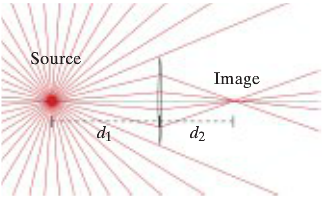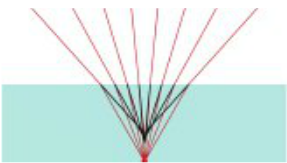Image Formation
Short Description of Topic
An image is an apparent source of light it is not a real light source because there is no actual image at the location of an image[1].
The Main Idea
Image formation by a lens depends upon the wave property called refraction.The speed of light is slower in glass than in the air, therefore a light ray will be bent upon entering and upon exiting a lens in a way that depends upon the shape and curvature of the lens.
The Thin Lens Equation
There is a geometrical relationship between the focal length of a lens (f), the distance from the lens to the bright object and the distance from the lens to the projected image. This is given by the thin lens equation.

This equation shows that all rays that start at a distance d1 to the left of the lens will cross the axis at the same distance d2 to the right of the lens. This means that if you stand farther to the right and look towards the lens you will see a "lamp" like object at the new location. By this end this is called an image because it is apparent source of light however there is no actual object at the location of the image.
Now the thin lens model or equation does have limitations. These limitations are called aberrations. Rays do come ALMOST at the same point but alas not exactly at the same point, and this difference can lead to "mistakes" or aberrations in image formation. You can see how the rays do not exactly come at the exact same point in the image below.
Virtual Image
We will now explore rays that go through weak lenses, these images the rays form are often called "virtual images".
So how do virtual images appear? Virtual images appear when outgoing rays from a point on an object always diverge, this causes the image to appear to be located at the point of divergence.Virtual images do not form visible projections on screens, however it is not "imaginary" because the image has a real position and size and also it can be seen by many different types of instruments (eyes, camera, etc). Below you can see how virtual images are formed. The rays appear to be coming from a location above the source therefore this is an example of a virtual image.
Connectedness
I personally have had a lot of issues with eyes. I've had to wear countless different lenses (glasses or contacts) so this topic hits home to me. It is nice to finally see what is really going on in regards to how vision works, and how it interacts with different lenses. I also find the manipulation of light to be very interesting. The way optical devices reflect and refract light in order to manipulate images is very cool. I think that different companies use image formation in so many different fields whether that be the movie industry or the medical industry manipulating image formation is a very large part of many different fields in the world.
In regards to my major image formation is not directly related however it is always good to have knowledge on a subject that has so many uses in the world.
See also
http://www.physicsbook.gatech.edu/Lenses
References
1. http://hyperphysics.phy-astr.gsu.edu/hbase/geoopt/image2.html 2. Matter & Interactions is a textbook by Ruth Chabay and Bruce Sherwood 3. http://hyperphysics.phy-astr.gsu.edu/hbase/geoopt/image.html

